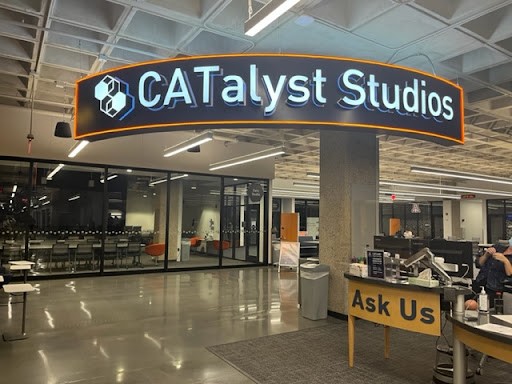There are many libraries to frequent on campus, including the University of Arizona Main Library and Albert B. Weaver Science-Engineering Library. Students tend to find their study spot and stick to it; however, there are many hidden treasures to explore at these locations.
The UA Main Library can be packed at all hours of the day, but the abundant resources are commonly missed. Some students and staff revealed their favorite places to frequent, whether to study or spend time on their craft.
UA Main Library
As you walk into the Main Library, a large sign saying “CATalyst Studios” welcomes you. The CATalyst Studios is a collaborative learning environment with a variety of uses. The space includes a maker, data and virtual reality studio.
The maker studio is very unique as it includes 3D printing, sewing stations, wood carving and other resources to explore one’s creativity. The hope is for students to use the space for both academic and nonacademic purposes.
Jesus Villalobos is a training developer for Access and Information Services at the UA Main Library and Albert B. Weaver Science-Engineering Library. There is no pricing on the services which creates a welcoming atmosphere for all interests, Villalobos said.
One of the coolest aspects of the virtual reality studio is the green screen room which includes an infinity wall and high end headsets. The library wanted to encourage different kinds of creations in all disciplines of study as well as for the community. Visit the CATalyst Studios website for more information and reserving rooms.
The UA main library also includes a variety of distinct sections such as the Media section in the basement. Students do not visit it often, but there are many cool DVDs, CDs, etc, Villalobos said. Students can find popular movies as well as obscure media to explore.
Villalobos discussed the microform and microfilm section on the third floor. It offers preserved papers and film from before digitization. They offer older unused readers as well as a modern way to examine these microforms for a blast into the past.
“The space is usually used by people doing in-depth research and know what they are looking for, and they know that the information is located in the space that people don’t really frequent,” Villalobos explained.
If you are ever in need of complex editing software that is not usually available on laptops, the Multimedia Zone will be your best friend. These computers offered on the first floor include software for graphic design, animation, video editing and more. The best part of it all: the zone includes consultants from the office of student computer resources who are trained in the programs and ready to help, Villalobos said.
Albert B. Weaver Science-Engineering Library and beyond
Near the UA Main Library is the Science-Engineering Library. The library recently underwent renovations for user-friendly collaborative spaces and updated study rooms.
Although many of the sections are dedicated to STEM, they also offer works on fine arts. As the Fine Arts Library is closed for renovations, an exciting initiative to transform the fifth floor of the Science-Engineering Library is taking place.
The fifth floor will most likely include practice rooms with sound proofing, piano rooms and collaborative spaces to make up for the temporary loss of space at the School of Music, Villalobos said.
These diverse spaces harness creativity and multidisciplinary learning. One unique spot located at the UA Health Sciences Library, located at the College of Medicine, is their meditation rooms. Students can reserve these rooms to practice meditation or have a calm safe space for reflection. These are very valuable rooms as many people use the space for prayer due to the privacy and peace, Villalobos mentioned.
For more information about other resources and making reservations, visit the University Libraries website.
Follow Ellen Nangia on Twitter















